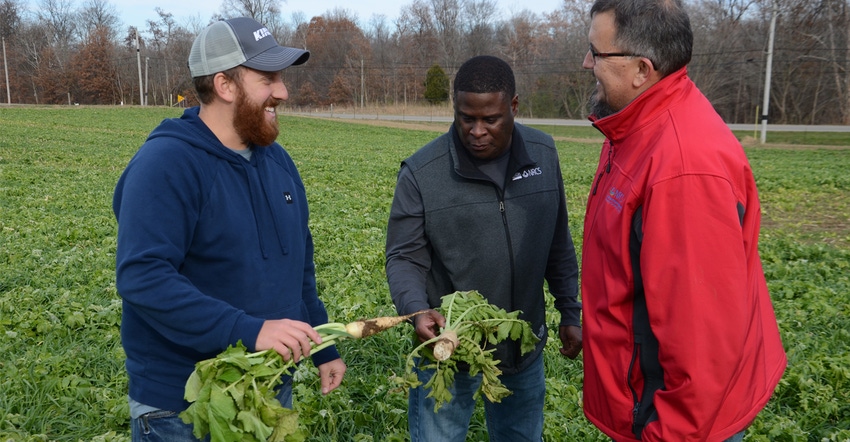
Anyone traveling along U.S. 231 north of Loogootee in Martin County, Ind., last fall should have seen a green crop growing in a field. And it wasn’t volunteer soybeans or volunteer corn. This crop was seeded on purpose to accomplish very specific goals.
“We really like cover crops,” says Caleb Richer, Loogootee. “They’re a really good fit on our farm.”
It’s no more complicated than that, Caleb says. They grow cover crops to achieve several tangible benefits, which they can tick off succinctly.
“The field along the road included radishes,” he says. “We chopped silage there for our beef cattle operation, and then seeded cover crops after chopping. It gives them a good start, and it provides cover to protect the soil. There isn’t much residue left after you take off silage.”
Caleb and his brother Jonathan live side by side on the family farm. Their father, Dale, began farming there in 1961, and he farmed with their uncle Jake. Caleb, an engineer by training, and Jonathan, a military veteran, both work off the farm as well. They took over the home farm a few years ago and have slowly improved buildings and expanded the cattle operation.
Why cover crops?
Here are the top reasons why they include cover crops and no-till on their rolling land, Caleb says.
Build organic matter. “We’re confident we can increase organic matter levels over time,” Caleb says. “Cover crops are a big part of it. We have a growing crop out there all the time. We also utilize manure, which also can help build organic matter levels over time.
“Our soils needed building up, and this is our plan to do it. We’re looking for a payback over time.”
Control other vegetation. The Richers prefer to have plants they want in the field rather than allowing winter annuals to run rampant in the fall. When they can establish a good cover crop stand of two or more species, they believe they can scavenge nutrients left after the cash crop was harvested. Eventually, those nutrients will return to the soil when the cover crop is terminated and decays.
Break up soil compaction. Here’s where the radishes come in, Caleb says. “We like how they produce long, deep roots underground,” he notes. “You not only get growth above ground, but what happens below ground is important, too.”
When radishes have time to grow in the fall, they can put roots deep into the soil, he says. He has dug up radishes to evaluate their girth and to see how deep they penetrate.
“We believe we’re getting valuable help on breaking up compacted layers that may be under the surface,” he says.
About the Author(s)
You May Also Like




